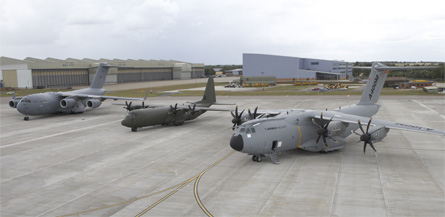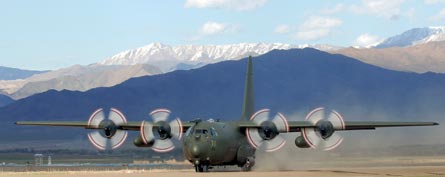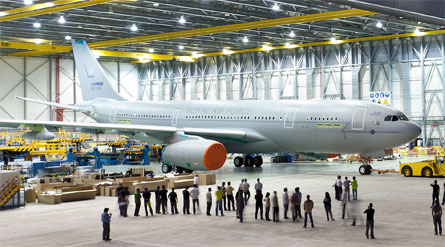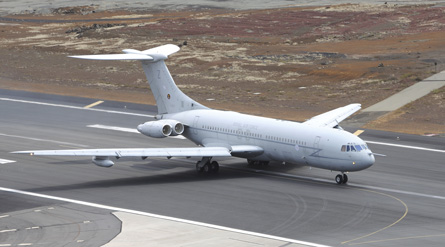If the UK's Strategic Defence and Security Review (SDSR) is all about "tough choices", then the Royal Air Force's transport aircraft fleet provides a striking example of the dilemma now facing the nation.
With its objective being to deliver massive departmental savings, the Ministry of Defence says: "Work has been set in hand to review all major equipment and support contracts to ensure the future programme is coherent with defence needs and can be afforded."
Chief of the air staff Air Chief Marshal Sir Stephen Dalton has voiced his desire to emerge from the process with a more balanced service, and warns that "platform-level" cuts will be a likely consequence of government-enforced cost savings.
"My aim is to come out of the SDSR with two fast-jet, two helicopter and two transport types," he says, referring to the project's expected 10- to 15-year period of regard.
While public attention has so far been focused on the likely effect of such a strategy on the UK's manned combat aircraft inventory, through the rumoured retirement of its BAE Systems Harrier GR7/9 or Panavia Tornado GR4 fleets, the possible implications for its air transport assets have not been aired widely.
But with the Boeing C-17 strategic airlifter and Lockheed Martin C-130J tactical transport already in use and Airbus Military's A400M due to enter operational service in 2015, one must fall casualty of the budgetary bloodletting if Dalton's vision is to be realised.
 |
|---|
© Airbus Military |
Three into two: which of the RAF's transport types will survive? |
Totalling more than 70 airframes, the RAF's current air transport and tanker inventory spans seven platform types, also including the older C-130K, Lockheed TriStar and Vickers VC10, plus BAe 125s and BAe 146s flown by its 32 (The Royal) Sqn.
Under current plans, the service's K-model Hercules will be replaced by the delayed A400M, and its TriStars and VC10s succeeded by modified Airbus A330-200s via the Future Strategic Tanker Aircraft (FSTA) programme. These processes should replace 36 aircraft with the same number - 22 and 14, respectively - and reduce the type-count by only one.
Four of the UK's remaining 14 C-130Ks (below) will be retired in the 2011-12 financial year, with the rest to go in 2012, when their home base at RAF Lyneham in Wiltshire will also close. Its 24 C-130Js will be relocated at its air transport super-base at Brize Norton in Oxfordshire.
 |
|---|
© Crown Copyright |
Set to remain in use until 2030, the C-130J fleet has been a workhorse in Afghanistan, where it performs short-haul transport tasks - typically moving around 2,000 coalition personnel and supplies each week, predominantly from Kandahar airfield. Combined with having made regular rough field landings, also during the UK's involvement in Iraq, the type, although younger than 15 years old, is already showing worrying signs of premature ageing.
A report published by the UK National Audit Office in June 2008 warned that the effects of deployed operations were so severe that wing replacement work could be required on some of the RAF's C-130Js from 2012 - one year before a bilateral fatigue study being conducted with Australia was due to conclude.
With other upgrade activities required in 2011-12, retirement of the last C-130Ks and the late arrival of the A400M, the RAF would be "unlikely to be able to sustain the current tactical capability", the audit office's June report said.
 |
|---|
The RAF currently operates seven transport aircraft types |
Unlike several of its partner nations on the A400M, the UK has so far made no interim arrangement to cover for the programme's roughly three-year delay. Indeed, its commitment to continue with the programme, as outlined in a March heads of agreement document, will see its original 25-aircraft purchase cut to 22 to compensate for increased costs.
Although suggestions persist that the UK could withdraw from the project entirely, Dalton and several senior politicians have backed the A400M, which made its first visit to Brize Norton on the eve of the Farnborough air show in July.
The UK had already spent more than £850 million ($1.3 billion) on the A400M by early this year, according to figures released by its Defence Equipment & Support (DE&S) organisation. The RAF now expects to receive its first example in 2014, and the type should enter operational use the following year, before achieving full capability from around 2018.
Plans for the A400M's arrival are already gaining traction, with discussions having been held with Airbus Military over a proposed joint support model for the planned 72 transports to be acquired by France and the UK. The latter also in mid-July issued an invitation to negotiate to Airbus Military and its partner Thales Training and Simulation for a proposed synthetic training service worth more than £400 million.
New training facilities will be built at Brize Norton under the proposed deal, which will support the instruction of pilots, loadmasters, maintainers and other personnel until at least 2030. Contract signature is expected in October 2011.
Another Airbus Military product, the A330-200 multi-role tanker/transport, is also approaching a key milestone before the first delivery in 2011 under the FSTA programme.
The first of two aircraft to have undergone modification at EADS's Getafe site near Madrid (below) will make its flight debut in tanker guise during September. The first aircraft is on track to arrive at Brize Norton in October 2011, and the EADS UK-led AirTanker Services consortium has completed major construction work on a new two-bay hangar and training building at the site.
 |
|---|
© Airbus Military |
Powered by two Roll-Royce Trent 772Bs, the aircraft will have a single-class cabin configuration with 291 seats. This will enable the A330 to initially be concentrated on air transport tasks, with its air-to-air refuelling capability not due to be used before late 2014. Full service provision is scheduled for mid-2016, AirTanker says, with around 500 military and civilian staff and sponsored reservists to eventually operate and support the types.
Half of the FSTA fleet will be two-point tankers equipped with Cobham 905E wing pods, while the remainder will also have a centreline hose drum unit to support larger aircraft, such as the A400M. The type will arrive with a 111t fuel capacity, achieved using the A330's existing fuel tanks.
Cobham Aviation Services will modify the UK's remaining 12 aircraft at its Bournemouth airport site in Dorset over a five-year period from the end of 2011. By earlier this year it had 35 employees working on the programme in Getafe in preparation for the activity.
The first two, Airbus-modified, aircraft will be used to support certification tasks, including from Qinetiq's Boscombe Down site in Wiltshire. Work to bring the A330 to the military configuration includes modifying 10 of its 25 civil-standard computers, and adding 31 new ones. New communications, navigation and datalink equipment is also introduced, with the tanker conversion process adding 10.9t to its empty weight, Airbus says.
Contracted only in March 2008, the private finance initiative FSTA deal has been the subject of considerable scrutiny, due to its estimated £13 billion cost over 24 years. With the project mentioned frequently as a potential casualty of the SDSR process, the MoD and industry have been pursuing possible ways of safeguarding the strategically vital air-to-air refuelling mission.
One suggestion to have been explored involves a potential bilateral arrangement with France, which has for several years been investigating ways of acquiring its own fleet of A330-based tankers. With a possible reduction in fast jet numbers on the horizon, the UK could require fewer tankers, potentially freeing up contracted airframes for French use.
This could prove an attractive proposition for both parties, although it would entail complex contractual renegotiation on issues such as the French air force's need to acquire aircraft with refuelling booms: equipment not selected for the RAF. An agreement would also further strengthen the proposed joint support model to be put in place for the nations' A400Ms.
The RAF's 101 Sqn retired two of its VC10s in April, after they had amassed a combined 81,500 flying hours. The 13 that remain in use will undergo a phased drawdown until the type's retirement in December 2013, some 47 years after the service placed the Rolls-Royce Conway-powered airliner into use.
 |
|---|
© Crown Copyright |
VC10s are now deployed to the Gulf region and to the Falkland Islands (above), and also support quick reaction alert duties in the UK. However, new operating guidelines introduced earlier this year as a result of the Haddon-Cave review have severely restricted its ability to carry passengers.
The last of the RAF's TriStars - six tankers and three transports - are due to leave use in 2016, as the FSTA fleet should reach full operational capability. Now providing vital personnel lift via the UK's "airbridge" with Afghanistan, the ex-British Airways and Pan Am aircraft are the subject of a modernisation package being performed by Marshall Aerospace. Intended to tackle obsolescence issues and ensure compliance with civil operating regulations, the work introduces new communication and navigation equipment and cockpit avionics.
Providing support for operations in Afghanistan remains a massive undertaking for the air transport fleet, which must support the movement of around 230,000 passengers a year from Brize Norton. Despite the age of its assets and the limited number of airframes that are available, the RAF says 83% of flights typically leave on time.
One type which appears certain to be safe through the defence review and subsequent cuts is the C-17, six of which are in use with the RAF's 99 Sqn. The UK is the leading international operator of the Boeing product, and will in December take delivery of its seventh example, three months ahead of schedule. Pictured below, UK7 recently underwent major join at the company's Long Beach manufacturing site in California, and is now moving along the assembly line.
 |
|---|
© Boeing |
The RAF's C-17s provide the backbone for the delivery of essential equipment such as support helicopters to and from Afghanistan, and also support tasks such as the evacuation of wounded personnel. The fleet has also been used to support humanitarian missions, for example delivering supplies in response to the earthquake in Haiti earlier this year, and tents following the recent devastating floods in Pakistan.
"Given the very weak state of our worn-out C-130J fleet and the delay before the delivery of the first A400Ms, no matter what SDSR provides, the RAF should have more C-17s," says Howard Wheeldon, senior strategist at London-based BGC Partners. The service has previously expressed a wish to field more of the type, which can carry more than three times the payload of a C-130J and over twice that of the A400M. However, this must be traded against its comparatively high per-hour operating cost, detailed by DE&S as £42,000, versus £12,000 for the C-130J.
Elsewhere, although the RAF's six BAe 125s and two BAe 146s have over the last few years expanded their duties from providing Royal and VIP transport services to also operating in Iraq and Afghanistan, their 2022 out-of-service dates could again come under review.
But Air Vice Marshal Steven Hillier, air officer commanding the RAF's 2 Group organisation, argues that the 32 Sqn aircraft have delivered "strategic-level effect" by having been adapted to non-traditional tasks. "Flying a regional commander to a meeting in a [BAe] 125 with three crew can cut six weeks of relationship-building" in Afghanistan, he noted earlier this year.
 |
|---|
© Jimbo314 on flightglobal.com/AirSpace |
The outcome of the SDSR process is likely to emerge around October, and only at this point will the future mix of the RAF's air transport fleet be confirmed.
A decision to cancel outright either the A400M or FSTA programmes is hard to imagine, or would indicate an acceptance by the UK government that the nation will have to significantly downgrade its ability to deploy and support its military forces on a global scale. Tough choices indeed.
Source: Flight International



















